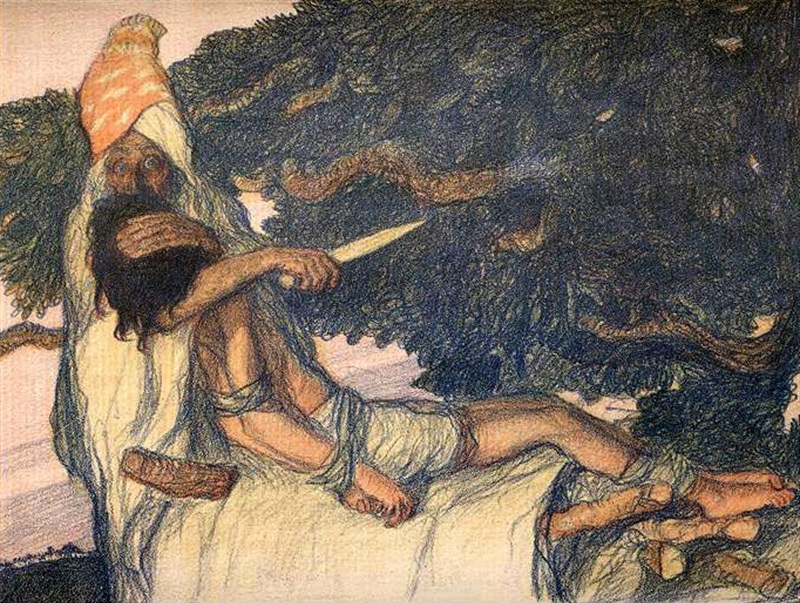Abel Pann (1883-1963), the Latvian-born and Paris-trained artist who joined the Bezalel Academy of Art and Design in Mandate Palestine, is mostly known today for two thematic clusters of his work: the representation of Jewish persecution in Europe around WWI (horrific black-and-white scenes that one can hardly view today without anachronistically associating them with the Holocaust); and The Five Books of Moses (1923), a collection of colorfully idealized paintings of the Bible, drawn mostly with bright colors and verve, clearly evoking the exotic orient.
None of this applies however to the image of the Akedah included in this book. This lithograph clearly lacks the brightness and life that mark the rest of the images here. It also bears no resemblance to traditional Jewish representations. With its gloomy dark green and faded, almost lifeless beiges, it seems to be the first Jewish artistic attempt to focus exclusively on the human protagonists of the scene while omitting other actors – most significantly, the deliverance duo, the angel and the ram. As such, it had established the rule of "no deliverance" that has since governed the Israeli grappling with the topos as a symbol of Israel's "national sacrifice"
Confronted with Isaac's bound and limp body, viewers of this painting are compelled to sense its physical pain, almost Caravaggio-style (The Sacrifice of Isaac, 1605). At the same time, the image gives the impression of a great intimacy between the binder and the bound, echoing perhaps Rembrandt's famous etching (Abraham's Sacrifice, 1655). Intriguingly, it is the father's face rather than the son's that expresses here the horror of the moment (see the "frozen" gaze in his eyes), underlined by the sharp knife still held in his hand. Indeed, Abel Pann fashioned the scene in the name of, or from the place of the fathers of the"Isaacs" of his time (the turbulent 1920s); hence the intense ambivalence and even guilt expressed in his [self?]-portrayal. Tragically, he seems to have anticipated his own fate. By the time he was to return to this topos in the late 1940s and 50s he would be a bereaved father, one of many, of the Israeli War of Independence. His own beloved first-born Eldad fell in Gush-Etsion on the eve of Independence (1928-May 14, 1948)
